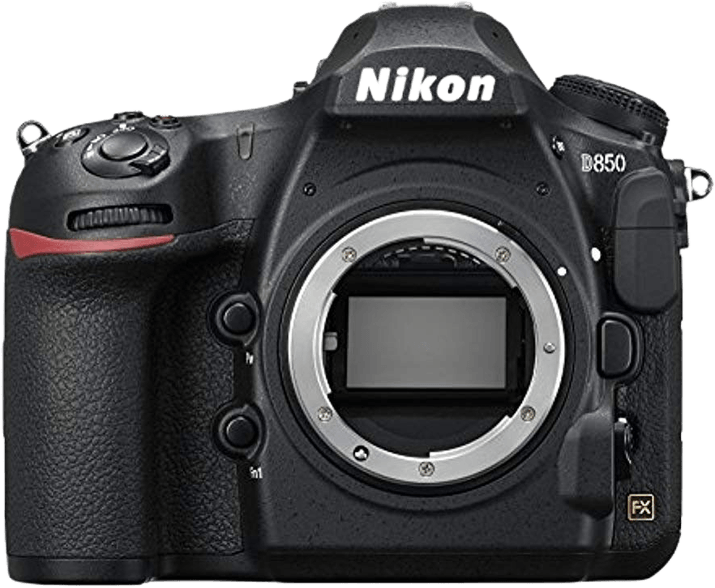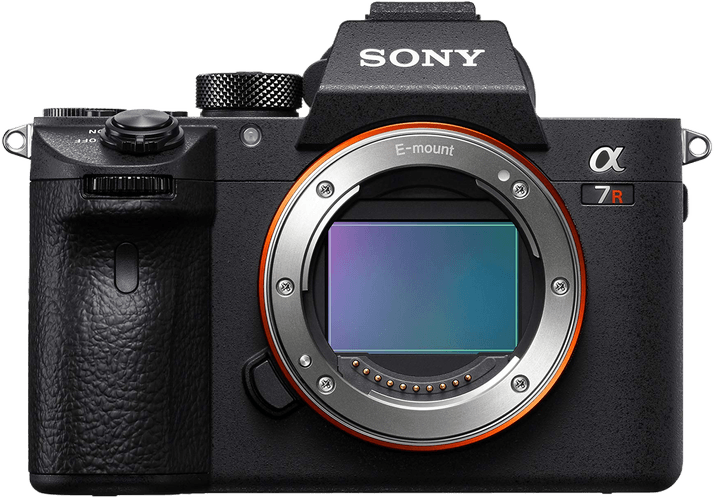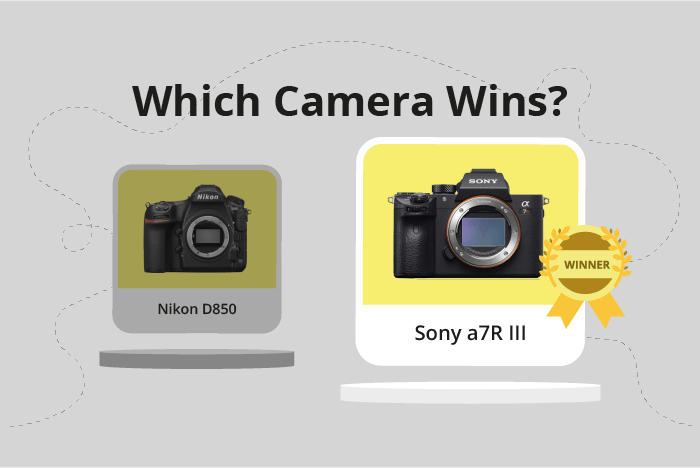Nikon D850 vs Sony a7R III Comparison
Nikon D850

Sony a7R III

The Sony a7R III narrowly wins with a score of 83/100 compared to the Nikon D850‘s 82/100. Both cameras were released in 2017, with the Nikon D850 announced on August 23rd and the Sony a7R III on October 25th. They share similarities in launch price, with the Nikon D850 priced at $3300 and the Sony a7R III at $3200.
The Nikon D850, a DSLR, excels with its larger body size of 146 x 124 x 79mm and heavier weight of 1005g (2.22lbs), providing a more robust and stable shooting experience. On the other hand, the Sony a7R III, a mirrorless camera, boasts a smaller, more portable size of 127 x 96 x 74mm and lighter weight of 657g (1.45lbs), making it ideal for on-the-go photography.
In comparing these cameras, the Nikon D850 offers sturdiness and stability, while the Sony a7R III provides portability and convenience. Ultimately, the choice depends on the photographer’s preferences and needs.
Nikon D850 vs Sony a7R III Overview and Optics
The Sony a7R III takes the lead in optics with a score of 84/100, compared to the Nikon D850’s score of 79/100. Both cameras share some common specifications, such as a CMOS sensor, full-frame sensor size, and a DXOMARK sensor score of 100. However, there are notable differences that contribute to the Sony a7R III’s higher score.
The Sony a7R III has a faster shooting speed of 10 frames per second, compared to the Nikon D850’s 7 frames per second. This allows the Sony a7R III to capture fast-moving subjects more efficiently. Additionally, the Sony a7R III features image stabilization, which helps reduce camera shake and produce sharper images, especially in low-light situations. The Nikon D850 lacks this feature.
The Nikon D850 does have a slightly higher megapixel count, at 45.7, compared to the Sony a7R III’s 42.4. This means that the Nikon D850 can capture more detail in images. However, the difference in megapixels is not significant enough to outweigh the benefits of the Sony a7R III’s faster shooting speed and image stabilization.
When it comes to lens mounts, the Nikon D850 uses the Nikon F FX mount, while the Sony a7R III uses the Sony FE mount. This difference may be a deciding factor for photographers who already own lenses compatible with one of these mounts.
In the end, the Sony a7R III outperforms the Nikon D850 in terms of optics, primarily due to its faster shooting speed and image stabilization. The Nikon D850 does offer a slightly higher megapixel count, but this advantage is not enough to surpass the Sony a7R III’s overall optical performance.
Nikon D850 vs Sony a7R III Video Performance
The Nikon D850 outperforms the Sony a7R III in video capabilities, with a video score of 70/100 compared to the Sony’s 56/100. Both cameras share some common specifications, such as 4K max video resolution, 3840 x 2160 max video dimensions, and a max video frame rate of 30fps. However, there are notable differences that contribute to the Nikon D850’s higher score.
One significant advantage of the Nikon D850 is its built-in time-lapse functionality. This feature allows users to create stunning time-lapse videos without the need for external software or accessories. The Sony a7R III lacks this built-in function, which may be a disadvantage for videographers who frequently utilize time-lapse techniques in their projects.
While the Sony a7R III does not excel in any specific video capability when compared to the Nikon D850, it still offers reliable and high-quality video performance. Its 4K resolution and 30fps frame rate are on par with the Nikon D850, and it can produce visually appealing videos for various purposes. However, the absence of built-in time-lapse functionality does set it back in comparison.
Considering the video capabilities of both cameras, the Nikon D850 proves to be the better choice for videographers due to its higher video score and built-in time-lapse functionality. Although the Sony a7R III is not a poor performer, the Nikon D850’s additional features make it a more versatile and practical option for individuals who prioritize video performance in their camera selection.
Nikon D850 vs Sony a7R III Features and Benefits
The Nikon D850 outperforms the Sony a7R III with a feature score of 87/100 compared to Sony’s 83/100. Both cameras share several specifications, such as touchscreen capability, the absence of GPS, and the inclusion of WIFI and Bluetooth connectivity. However, there are key differences that set these cameras apart.
The Nikon D850 boasts a larger screen size of 3.2 inches and a higher screen resolution of 2,359,000 dots, making it superior in terms of display quality. This allows for a clearer and more detailed view of images and settings, enhancing the overall user experience. The presence of a touchscreen further improves the ease of use and navigation through the camera’s menus.
On the other hand, the Sony a7R III has a flip screen, a feature that the Nikon D850 lacks. This flip screen offers greater flexibility in shooting angles and is particularly useful for capturing images from challenging perspectives. This advantage is especially beneficial for photographers who frequently shoot in unconventional positions or need to compose their shots from various angles.
In terms of features, the Nikon D850 is the stronger contender due to its larger screen size and higher resolution. The Sony a7R III, however, offers the advantage of a flip screen, providing added versatility in certain shooting situations. Ultimately, the choice between these cameras depends on the specific needs and preferences of the photographer. The Nikon D850 is better suited for those who prioritize display quality and ease of use, while the Sony a7R III is ideal for photographers seeking flexibility in shooting angles.
Nikon D850 vs Sony a7R III Storage and Battery
The Nikon D850 outperforms the Sony a7R III in storage and battery with a score of 84/100, compared to Sony’s 65/100. Both cameras share common specifications, such as two memory card slots and compatibility with SD, SDHC, and SDXC (UHS-II) cards. However, the Nikon D850 has an advantage with an additional XQD card compatibility.
The D850’s battery life significantly surpasses the a7R III, providing 1840 shots per charge with its EN-EL15a battery, while the Sony a7R III offers only 650 shots with its NP-FZ100 battery. Neither camera supports USB charging.
Although the Sony a7R III has a lower score in this comparison, it still offers reliable storage options and a decent battery life for a wide range of photography needs. However, the Nikon D850’s superior battery life and additional memory card compatibility make it a stronger choice for those prioritizing storage and power capacity.
Alternatives to the Nikon D850 and Sony a7R III
Are you still undecided about which camera is right for you? Have a look at these popular comparisons that feature the Nikon D850 or the Sony a7R III:

